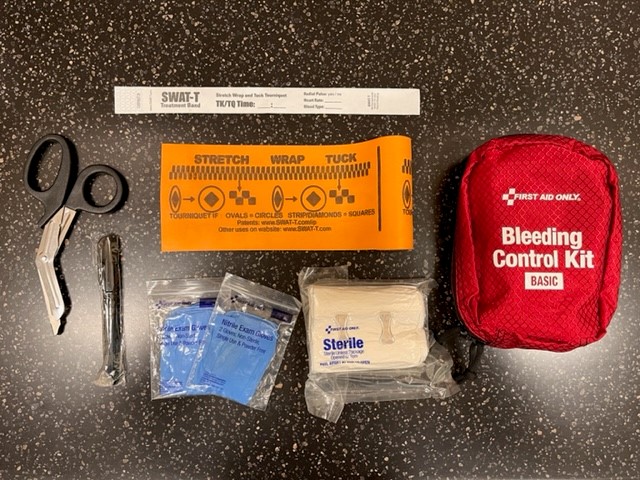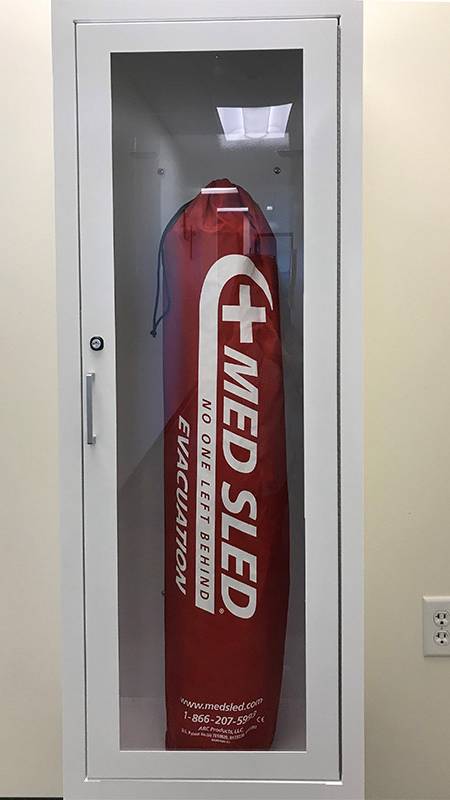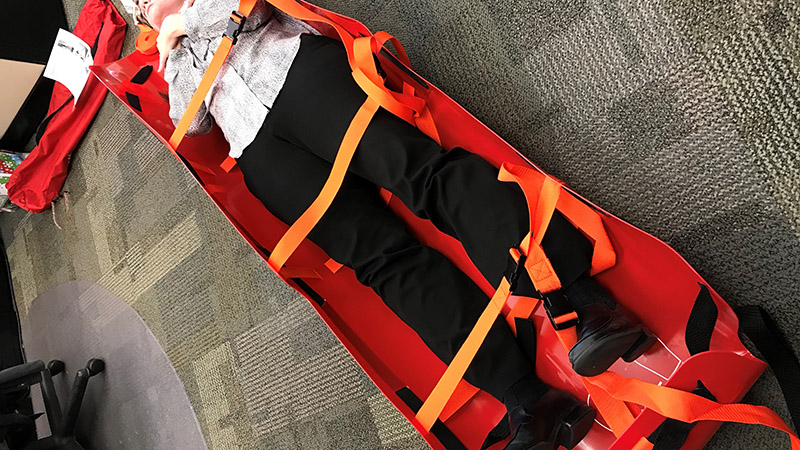Explore the categories below to learn more about being emergency prepared at uvu
UVU is committed to the safety of its campus community and to responding to emergency or disaster incidents in a safe, effective, and timely manner. There are several channels UVU will use to notify students, faculty, and staff of an emergency or incident. These include the main campus public announcement system, digital signage, web alerts, and social media. Two additional methods are UVU’s Emergency Information website, found at www.uvu.info, and mass emergency text messaging. To receive these emergency text messages, it is important to ensure the phone number UVU has on file is correct. Follow these steps to verify your information.
For Employees, follow the instructions below. The student instructions can be accessed here.
Step 1: Log in to myUVU Workplace.
Step 2: Access your settings by clicking on your profile picture on the top bar.
Step 3: When the next page opens, click on "Text Opt-In" under "UVID".
Step 4: Verify the phone number on the next page is correct.
Step 5: Periodically test your ability to receive alerts by clicking on the "Test Your Text Messaging" button at the bottom of the page.
Office Hazard Hunt
For optimal preparation, your department and/ or building should have an Emergency Preparedness Plan in place. This includes an evacuation map, emergency telephone list, and emergency assembly area. Be certain to hold periodic emergency evacuation and preparedness drills. Review the following lists to conduct a hazard hunt of your work area.
Earthquake
Evacuation Hazards
Fire and Electrical Hazards
Labs and Chemicals
Work Disaster Supply Kit
Disasters and emergencies can occur at anytime and anywhere. In addition to having a disaster supply kit at home and in your car it is a good idea to keep one at work. Your workplace disaster supply kit should have enough items to allow you to shelter-in-place for at least 24 hours. Here are some helpful tips when building your kit:
The following documents provide additional suggestions of items to include in your kit.
Consider including the following items in your kit:
Active Shooter
If you are involved in a situation where someone has entered the area and started shooting, the following is a list of actions that are recommended. It should be noted that these types of incidents are unpredictable. The listed guidelines are recommendations that are based on past national experiences. You may have to alter some of these suggestions depending on the situation.
Bomb Threat
IF YOU RECEIVE A BOMB THREAT:
TURN OFF ALL CELL PHONES AND TWO-WAY RADIOS. Their operational frequencies may cause detonation of an explosive device.
WHILE THE CALLER IS ON THE PHONE:
IF THE BOMB LOCATION IS KNOWN OR DISCLOSED BY THE CALLER:
BOMB THREAT CARD (obtain this information as possible, the caller will often times share this information)
Where is the bomb?
__________________________________________________________________________________
When will it go off?
__________________________________________________________________________________
How much time is left?
__________________________________________________________________________________
What kind of bomb it is?
__________________________________________________________________________________
What does the bomb look like?
__________________________________________________________________________________
Why is the building being bombed?
__________________________________________________________________________________
How do you know about the bomb?
__________________________________________________________________________________
Why are you calling?
__________________________________________________________________________________
What is your name?
__________________________________________________________________________________
Address?
__________________________________________________________________________________
Phone Number?
__________________________________________________________________________________
Time of call?
__________________________________________________________________________________
If the building is occupied, inform the caller that the explosion will cause death and injury.
Other details to listen for:
Voice Characteristics: Loud, soft, deep, high, raspy, pleasant, nasal, intoxicated, other:
__________________________________________________________________________________
Accent: Local, foreign, unusual characteristics, other: __________________________________________________________________________________
Location/Background Noise: office machines, aircraft, quiet, other: __________________________________________________________________________________
Campus Emergency
For CAMPUS EMERGENCY
If a life-threatening medical emergency occurs, call 911*
Calling 911 on a cell phone while on campus will put you in contact with Orem City Dispatch who will notify UVU campus police of the situation. University police may not be aware of the emergency until notified by Orem Police.
Chemical Spill
The SAFETY DATA SHEET (SDS) in your area is located: __________________________________________________________________________________
The FIRE ALARM closest to your area is: __________________________________________________________________________________
IF A SMALL SPILL OF HAZARDOUS MATERIALS HAS OCCURRED AND ONLY THREATENS THOSE IN THE IMMEDIATE VICINITY:
DO NOT ATTEMPT TO CLEAN UP THE HAZARDOUS SPILL
Call the UVU Police Department at 801-863-5555
Obtain and give as much information as possible to campus police and arriving emergency crews.
Example: Safety Data Sheets, if available
Name of chemical
Who has been exposed
Any injuries
Length of exposure
Size of spill
IF A LARGE OR LIFE-THREATENING SPILL OF HAZARDOUS MATERIALS HAS OCCURRED AND/OR THREATENS MORE THAN ONE ROOM:
DO NOT ATTEMPT TO CLEAN UP THE HAZARDOUS SPILL
Follow RAIN acronym
R: Recognize there is a problem
A: Avoid any contact with hazardous spill
I: Isolate the area by getting others away from the hazardous spill
N: Notify the UVU Police Department at 801-863-5555
Additional Actions:
Communications
UTAH VALLEY UNIVERSITY EMERGENCY COMMUNICATIONS PLAN
PURPOSE:The purpose of this plan is to aid in minimizing confusion and curbing escalation of inaccurate and erroneous information related to a problem or emergency at the university.
POLICY: University Marketing and Communications is the official channel through which any information concerning the university is to be disseminated to media sources.
COLLEGE SPOKESPERSON: The Senior Director of Communications will act as university spokesperson or will assign a Public Information Officer to act as such. During an emergency only the University spokesperson is authorized to provide information to the media.
Earthquake
IF YOU ARE INDOORS DURING AN EARTHQUAKE:
During the shaking:
After the shaking:
IF YOU ARE OUTSIDE DURING AN EARTHQUAKE:
IF YOU ARE IN A MOVING VEHICLE DURING AN EARTHQUAKE:
AFTER AN EARTHQUAKE:
University Response:
Elevator Failure
IF YOU ARE IN AN ELEVATOR THAT FAILS:
IN CASE OF ELEVATOR FAILURE:
IN CASE OF MISUSE, VANDALISM, OR OTHER PROBLEMS:
In the event of a power outage, facilities personnel will check all elevators.
Explosion
There may be a variety of reasons for an explosion on campus. Initially it may not be important why the explosion occurred, that will be investigated afterward
Evacuation
The building must be evacuated if the fire alarm sounds or if you are instructed to evacuate by an authorized Public Safety, Facilities, Building Captain/Marshal or Administrative representative.
WHEN INSTRUCTED TO EVACUATE THE BUILDING:
Fire
The FIRE EXTINGUISHER in your area is located: __________________________________________________________________________________
Please become familiar with its use. The Fire Marshall will train you if requested (801-863-8021).
The FIRE ALARM closest to your area is located: __________________________________________________________________________________
IF IT IS A SMALL, EXTINGUISHABLE FIRE:
IF THE FIRE CANNOT BE EXTINGUISHED WITH A FIRE EXTINGUISHER:
Activating the alarm will automatically report the fire to UVU’s Police Department.
WHEN A FIRE ALARM SOUNDS:
Life Threatening Medical Emergency
IF THE EMERGENCY APPEARS TO BE LIFE-THREATENING:
(Examples: unconsciousness, inability to move, potential spinal injuries, broken bones, uncontrollable bleeding, heart attack, stroke, inability to breathe, etc.)
Minor Medical Emergency
POST ACCIDENT INJURY – CONTACT THE UVU POLICE DEPARTMENT AT 801-863-5555
Occasionally accidents will occur wherein individuals, including the accident victim, will assume that no injury has occurred and that no medical attention is required. However, symptoms may become evident later, and an accident report should be filed as soon as possible with the UVU Police Department at 801-863-5555.
If STUDENT or NON-EMPLOYEE is injured:
If EMPLOYEE injury:
Natural Gas
IF YOU SMELL NATURAL GAS IMMEDIATELY EVACUATE ALL PERSONS FROM THE BUILDING AND CALL 911 AFTER LEAVING THE BUILDING.
The unusual smell is a harmless chemical that Questar Gas adds to natural gas so even the smallest leak is easy to detect. This odorant is added as a safety precaution because natural gas has no odor of its own.
Non-Life-Threatening Emergency
IF THE EMERGENCY REQUIRES MEDICAL ATTENTION BUT APPEARS NOT TO BE LIFE-THREATENING:
(Examples: Cuts, abrasions, sprains, fainting spells, simple fractures, etc.)
If STUDENT or NON-EMPLOYEE is injured:
If EMPLOYEE injury:
DO NOT TRANSPORT INJURED PERSONS IN PERSONAL VEHICLES.
Power Failure
Consider purchasing a FLASHLIGHT for your area/office.
At the beginning of each semester, ask the following questions:
IN CASE OF POWER FAILURE:
AFTER A POWER FAILURE:
Psychological Services
Student Health Services 801-863-8876
As with individuals, the UVU community will suffer trauma and psychological distress in the aftermath of disasters or crimes. Almost everyone will be in shock, yet each individual is likely to react with a different set of emotions, which may include sadness, anger, fear, helplessness or euphoria. Also, caregivers in the community (fire, police, etc.), wanting to help in the crisis, may themselves be affected by a sense of shock.
The UVU Student Health Services crisis team would respond to assist victims of traumatic stress on our campus. Crisis team services would include, but not be limited to, crisis intervention, post-trauma counseling, group crisis interventions, death notification, etc.
There are three primary tasks the team performs:
Risk Management
RISK MANAGEMENT:
FOR HAZARDOUS OR UNSAFE SITUATIONS THAT HAVE OCCURRED OR MAY OCCUR CONTACT UVU’S ENVIRONMENTAL HEALTH AND SAFETY AT 801-863-8560.
If it is after regular office hours and is imminently dangerous, call the UVU Police Department at 801-863-5555
Safety Tips
SAFETY TIPS AND SUGGESTIONS BEFORE ANY TYPE OF EMERGENCY OCCURS:
SAFETY TIPS:
Emergency Response Teams and the UVU Police Department are the only persons authorized to enter a hazardous area. Building occupants must evacuate if the fire alarm sounds or you have been instructed to do so by an authorized Public Safety, Facilities, or administrative representative. Remain outside until directed to return by the police or other official.
Snowstorms or Severe Weather
SCHEDULE CHANGE
Please reference www.uvu.info for additional information about changes to campus schedules. Every effort will be made to communicate with the campus community about schedule changes.
Additional Information
If serious storms cause a change in the university schedule, TV and radio stations will be contacted by University Marketing & Communications as soon as possible and will be asked to broadcast the necessary information regarding changes to the campus status and class schedules. Classes in session will be contacted and informed about early dismissals, if required. A push notification will be used through the UVU App as well.
Threatening Person
WHEN CONFRONTED BY A THREATENING PERSON (verbal or behavior/actions):
Help the police by reporting any crime as soon as you can. The chance of catching someone diminishes with the passage of time.
Violence Prevention
WORKPLACE VIOLENCE PREVENTION:
UVU is committed to maintaining a safe work environment. Given the increasing level of violence in society, UVU has adopted the following guidelines to deal with intimidation, harassment, or other threats of or acts of violence that may occur on its premises.
UVU encourages employees to bring their disputes with other UVU community members to the attention of their supervisors or the Division of People of Culture at 801-863-8207, before the situation escalates into potential violence.
Violent Incident
CALL 911
Violent or potentially violent incidents may include:
IF YOU SEE OR HEAR A VIOLENT INCIDENT ON CAMPUS:
FOR EMERGENCY ASSISTANCE CALL UVU POLICE AT 801-863-5555 OR 911.
Water Leak
IN CASE OF WATER LEAK:
After 5 p.m. and on weekends, contact the UVU Police Department at 801-863-5555.
EMPLOYEE PREPAREDNESS SCAVENGER HUNT
(Downloadable copy below)
An Active Shooter is an individual actively engaged in killing or attempting to kill
people in a confined and populated place. Typically, the immediate deployment of law
enforcement is required to stop
the shooting and mitigate harm to victims. Active shooter incidents often begin and
conclude quickly, and the incident may be at any location. This leaves university
police very little time to coordinate response procedures with off campus law enforcement
and students, faculty and staff. Individuals must be prepared both mentally and
physically to deal with an active shooter situation. The response to a specific incident
will depend on the circumstances unique to that incident. However, there are general
procedures that apply to all active shooter incidents.
Considerations for Specific Areas
Employee/Student Training and Awareness
About Stop the Bleed
Stop the Bleed campaign encourages bystanders to become trained, equipped, and empowered to help victims in a bleeding emergency before professionals arrive on scene. In such an event, knowing how to properly stop the bleed can save a life. UVU has bleeding control kits placed in AED cabinets all around campus. To schedule a live Stop the Bleed training for your employees contact Robin Ebmeyer at 801-863-7797 or via email at [email protected].
Included in the Stop the Bleed kits around campus are:

WHEN INSTRUCTED TO EVACUATE THE BUILDING:
UVU Evacuation Devices
Med Sled Evacuation Devices allow for evacuation from buildings in emergency situations.
Med Sled Devices are located around campus. To schedule and Evacuation Device training
for your area contact Robin Ebmeyer at 801-863-7797 or via email at [email protected].
The following video is a instructional demonstration of the MedSled Evacuation Device.


Optional trainings for departments are available. Trainings include
To schedule a training contact: